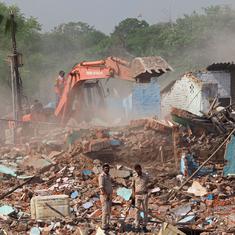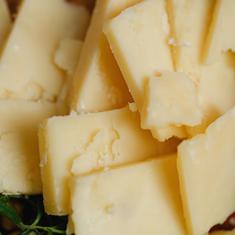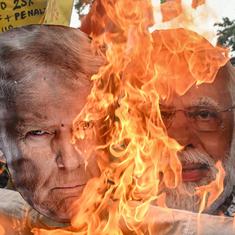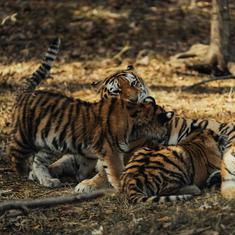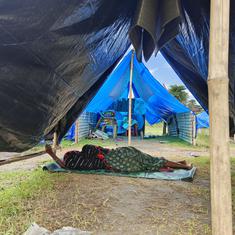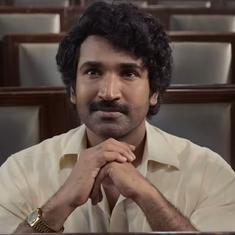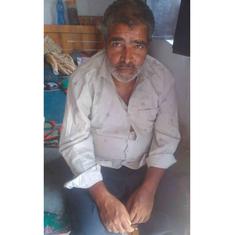On the first day of the Navarasa Sadhana workshop, while practising eye exercises, we were asked to look up to the heavens and deep down towards the netherworld. “Look so hard that you forget your body,” directed G Venu, or Venuji, as he is commonly called. “The scenes must have a photographic clarity.”
The 15-day workshop at the institute Natanakairali in the temple town of Irinjalakuda in Kerala was driven by the power of imagination – and Venu’s deep reservoirs of experience. A renowned artiste of the theatre tradition Koodiyattam, Venu had set up Natanakairali in 1975 to preserve traditional art forms of Kerala that were on the verge of decline. His Navarasa Sadhana workshops – an acting manual for performers for the last eight years – attempt at conserving fading traditions as well.
At the core of the workshop in March was the navarasas (nine emotions) mentioned in sage Bharata’s Natyashastra (a Sanskrit text on the performing arts), the techniques of Koodiyattam, and the Swaravaayu (sound of breath) philosophy crafted by the Kodungallur royal family. While enacting the emotion of veera (courage), our icon was Ravana, as he lifted Mount Kailasa. Our knees were on fire as we sat in the bent Koodiyattam posture, while emulating the demon king. We became an enraged Bheema as we explored krodha (anger). We screamed, jumped and danced as our bodies shivered in intense rage.

Time paused at Natanakairali. Although we found the serenity jolting at first, we gradually started waking up early, practising eye exercises and getting used to surprise visits by inquisitive snakes and hyper-active bees. Little things – watching Venu’s grandson play with the dogs, watching wide-eyed a Koodiyattam show by Kapila Venu, our master’s renowned artiste daughter, and relishing the rice and coconut-based gravy served by the chechis in the little kitchen – brought us joy. The energy each participant brought to the place was unique. In Venu’s words, our seven member-strong tribe from France, India, Mexico and Dubai struck “a balance”.
Venu’s contribution to modern theatre is the rediscovery of the vyabhichari bhavas or transitory states. “Vibhava (determinants), anubhava (consequents) and vyabhichari bhavas result in rasa, the aesthetic enjoyment in the audience, according to Bharata,” he explained. The 33 transitory states consist of around 500 experiences, such as insult, torture and extreme illness. At the workshop, we went through each of them by devising improvisations that helped us mix and match diverse emotions to co-relate to the respective vyabhichari bhava. It was similar to a painter blending elementary colours to create a nuanced palette.

“Vyabhichari bhava is an experience, not a performance,” reminded Venu. As we were under no obligation to entertain, we indulged in a slow, delicious exploration of each bhava. We locked ourselves in rooms like lunatics, roamed around for food, wept over the loss of a dear one and experienced an imagined illness. While being involved in each act, we interacted with our immediate surroundings – the trees, plants and ponds. I was emotionally drained but cleansed at the end of each day. I felt like I was tending to some part of me that had been unaddressed all this while.
The discovery of the vyabhichari bhavas was the most revolutionary aspect of the workshop. As we experienced each bhava, we began shifting into a trance-like state. I even ate leaves and rotten fruit strewn around the ground while enacting “starvation”. We were also instructed to experience the navarasas through Koodiyattam, but the process was far from mechanical – for example, the jumps performed to enact adbhuta (mad joy) agitated us and helped us fall into a trance.
Paradigm shift
At a time when theatre schools are slowly beginning to understand the value of traditional performative systems, rituals and body vocabulary as crucial for new theatre explorations, here was a man offering an acting manual that’s traditional and post-modern at the same time. The emphasis on impulse and ritual in tapping a primal energy in our bodies, as suggested by Polish theatre director Jerzy Grotowsky, is strikingly similar to Venu’s approach. In his book Towards a Poor Theatre, Grotowsky describes trance as “the ability to concentrate in a particular theatrical way and can be attained with a minimum of good will. If I were to express all this in one sentence, I would say that it is a question of giving oneself.” This mirrors what we felt.

It is no surprise that Venu subconsciously finds resonance with Grotowsky. The latter’s Paratheatre group has worked with Venu’s students in the past. But, according to Venu, “They were interrogating the actors on their process and on what exactly happens in their mind and bodies when they are emoting. They were behaving like scientists. You cannot attempt to understand these things.” Venu never interferes with the process of an actor. At no juncture did he intervene in our performance or give feedback. “You have performed and watched others perform,” he said. “You can learn yourself.”
During the workshop, we felt a spiritual awakening. The sessions were not merely about learning acting, but about creating a paradigm shift in life. For instance, while enacting bheebatsam (disgust), Venu said, “Without disgust, there is no death. None will be fed up of life.” We visualised the war scenes from the Mahabharata – standing in the battlefield carpeted with corpses and encircled by vultures – to explore this emotion. This philosophical reflection on disgust was a revelation and softened my attitude towards death. It helped me internalise the oft-quoted, almost clichéd, line that “death is as natural as life”.
While enacting santham, the ninth navarasa, we were asked to be a character nearing his or her death. My grandmother’s life flashed in front of me like a film. We were asked to imagine the character seated opposite to us. “Now, leave all the emotions onto her and withdraw your vision,” Venu guided us. Finally, we were asked to inhale with a sound similar to the roar of a bull and fall back on the mat to breathe our last.

On the final day, we enacted all the bhavas – sringaram, adbhutam, veeram, krodham, bhayanakam, karunam, hasyam, bheebatsam and santham. The routine created a beautiful sense of detachment. With each bhava, we accepted life as it is, and as actors, maintained distance from the catharsis we experienced. As we were enacting one navarasa after another without a break, we weren’t allowed to deal with any kind of emotional residue. For instance, while enacting anger, we had to get excited and then enraged. The next emotion was bhaya (fear). We had no time to step out of our emotional state of anger and ease into fear. As soon as the mizhavu (the percussion instrument used in Koodiyattam) beats began, we were pushed onto the stage to experience fear, during which we had no agency or control. We were submissive, at the lower end of the power hierarchy between our attacker and us.
This apparently ritualistic act drilled the truth that emotions are transitory into our subconscious. And that in turn led to a beautiful sense of acceptance of life in all its blacks, whites and greys.
All photos courtesy Natanakairali.
